Dieser Blogpost ist auch auf Deutsch verfügbar
More and more companies, especially those for whom knowledge is essential, are facing the challenge of how they can better involve their excellently trained employees in the design of workflows and decision-making. The employees should and want to take responsibility appropriate to their level of knowledge. If all employees contribute to the company with full capacity, creativity, all their skills and abilities, only then the company will reach its full potential.
The question arises which organizational form aids the company to reach its full potential. Frédéric Laloux addresses this question in his book Reinventing Organizations. He first presents the historical development of organizational forms in general. They ultimately lead to the newest form: the integral evolutionary organization that is in the main focus of this text.
The objective of this publication is to summarize the core ideas of integral evolutionary organizations. For this purpose, the text recapitulates the historical development of organizational forms according to [1], illuminates the most important aspects of integral evolutionary organizational forms using [1], [2] and [3], in order to finally highlight challenges that one faces during a transfer in practice.
Historical View on the Development of Organizations
Organizations of people developed in stages. The following models below delineate this development.
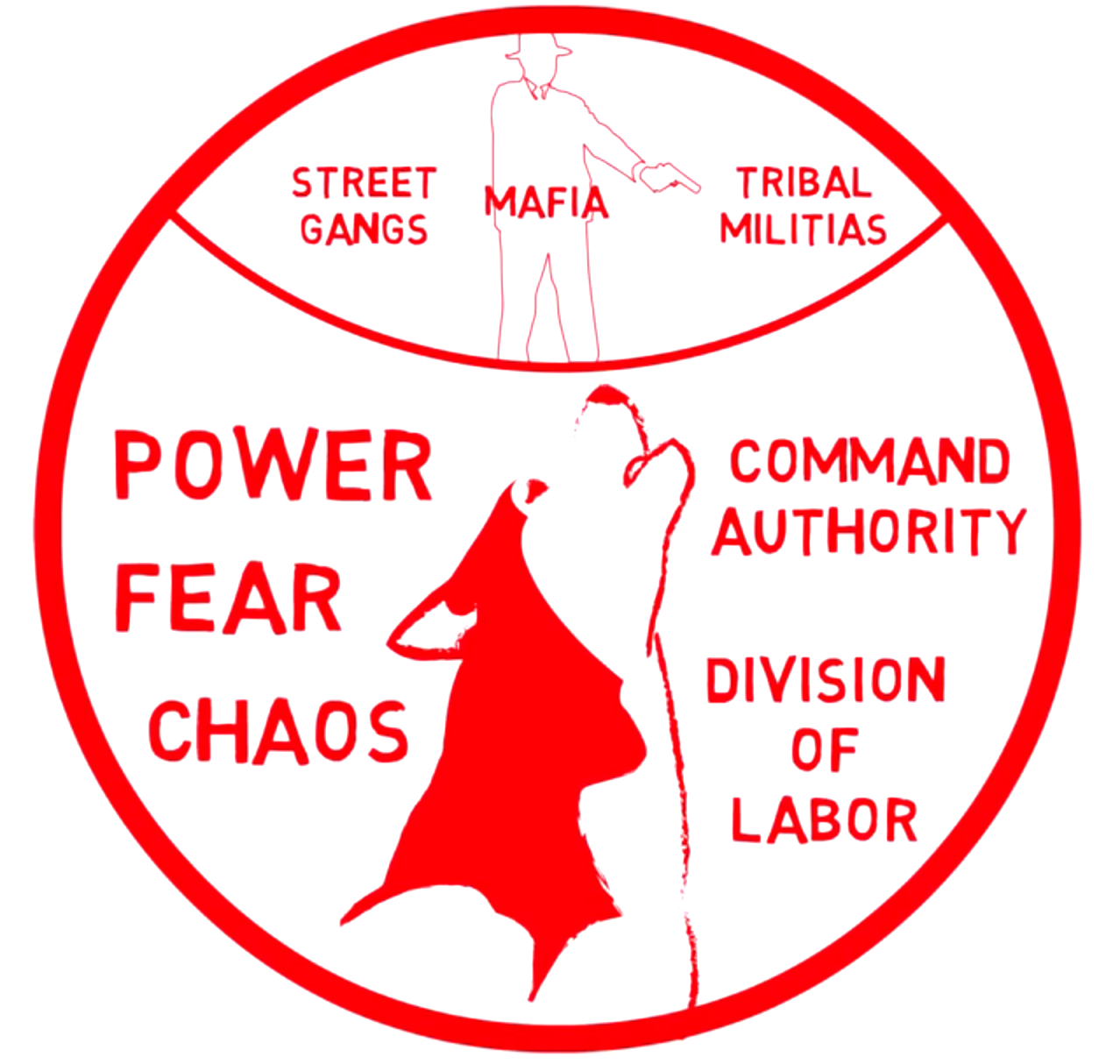
After a few preliminary stages, people organize themselves following the tribal impulsive paradigm (red). In contrast to previous stages of development, people are aware of themselves. As part of a larger whole, they are aware of their minor importance and the fact that they can suffer and die. Therefore the world is seen as a dangerous place. The currency of this world is power. If you have more power, you can have your own needs met. A powerful leader, like an alpha of a wolf pack, guides the group through the chaos with authority through command and control, causing fear to the enemies. The clear division of labour assigns each member of the group a clear area of responsibility. Because long-term planning is difficult in life-threatening, chaotic environments, short-term plans prevail. Even today, such organizational structures can be found in dangerous, chaotic living environments such as the mafia, street gangs or tribal militias [4].

In the conformist paradigm (amber) people learn to perceive the linear course of time (past, present, future). It becomes possible to pursue long-term goals. The formation of a clear hierarchy with clearly defined processes and formal roles ensures stability and control. The individual does not have to know the leader personally, it is enough that information is passed down along the hierarchical chain of commands and that group members share a common basic idea. The conformist paradigm allows to form early states. Such structures can still be found in the military or in churches. For example, the Catholic Church has been built on the Byzantine state and still follows this paradigm. Even though this form of organization can scale and pursue long-term goals, it is difficult for it to adapt if goals are to change.
The French revolution, as well as the industrial revolution, lead to the development of the modern performance-based paradigm (orange). In conformist organizations, the status resp. the assigned role in society is decisive. Now, in orange organizations knowledge and performance count. They allow to develop new business models based on innovation. As part of competition, newly emerging industrial companies strive for profit. Factory owners set goals and strategies. Workers who routinely take over their assigned sub-tasks within a system marked by the division of labour and designed for efficiency. In such a system, workers can only shape the way how to implement their sub-task. They are accountable for their actions. The machine metaphor describes well this type of company, where the individual is a small cog in the gearbox, while the company owner turns the big wheel. Today’s large and public companies follow this organizational pattern. The people in the gearbox cannot contribute with all their capabilities to the goals, but must limit their actions to the area of responsibility assigned to them. This implies that they are no longer committed to the work.
The next stage of development, the postmodern pluralistic paradigm (green), addresses this problem by trying to find a balance between the different stakeholders. This paradigm does not only take into account the interests of company owners / managers and employees, i.e. internal company stakeholders, but generally also those of all economic and social stakeholders. Common values are in the foreground. Processes and organizational charts take the back seat. The family metaphor describes the pluralistic organization, in which everyone involved is empowered to generate added value for the customers, based on the shared values. With the increasing size of these organizations, usually managing directors or even middle management emerge that take up roles in the system. However, these hierarchies then collide with the individual development efforts of the family members.
Integral Evolutionary Organizations

The integral evolutionary organization (teal) abandons the pyramidal concept of hierarchies. Circles of members, according to topics or tasks, form a structure that is close to a biological organism composed of cells. Members may have multiple roles, so they can be part of multiple circles. Circles can be nested and they are all surrounded by an anchor circle [2]. Such resilient organizations consisting of circles are held together by a common purpose of the organization. This purpose is not given by the founders / owners, but determined by the organization itself and from then on developed evolutionarily. Each group decides independently by means of a consent for its area of authority and without consultation from outside, which leads to a distributed decision-making process (in contrast to consensus, not all participants need to agree, but they consent to the proposed decision). People are meant to contribute with wholeness to the organization. That implies that they are not limited to rationality, but add emotions, intuition and spirituality. Self management, the evolutionary purpose and wholeness form the core elements of integral evolutionary organizations. [1]
While modern performance-oriented organizations focus on charts and processes, postmodern pluralistic organizations emphasize values. Neglecting the structures due to the focus on values does not lead to an integral organization. Ken Wilbers illustrates this with the four-quadrant model. For each individual person, but also for the collective, there is an internal view that the external viewer cannot perceive and an external view that can be measured from the outside. Figure 6 shows the model. A person’s mindsets and beliefs are not directly measurable, but their behaviour is. If a person simulates behaviour that contradicts their inner perspective, this leads to psychological stress in the long term. This can also be applied analogously to the collective. A company that wants to have a culture of free choice of individual employees, but has a management and middle management who make the decisions is not congruent.
In another example, one may assume that individuals are motivated by money payments. So one introduces single bonus payment when objectives are reached. The consequences are obvious: the most efficient individual behaviour is to do exactly what is necessary to receive the bonus payment and to focus on the individual success instead of the success of the team. Figure 7 shows this interaction of the four quadrants. Since teamwork is an important goal in most organizations, individual bonuses are replaced by team bonuses in integral evolutionary organizations.
Hence, Ken Wilber’s four-quadrant model illustrates the integral aspect of teal coloured organizations. Further aspects such as self management or evolutionary purpose, which form the core of integral evolutionary organizations, are considered below.
Self management in integral evolutionary organizations allows teams to make decisions independently of the upper levels. Hierarchies are dropped. Decisions are therefore made close to the context and source of knowledge. They allow quick reactions. In hierarchical organizations, only problems of significant size reach the management. In integral evolutionary organizations problems are addressed immediately at the source, i.e. close to the context, before they lead to costly consequences. In integral evolutionary organizations, critical decisions are always made by those affected. This also applies to teams that may integrate new employees. The team decides whether it wants to work with this new employee. A potential new employee must therefore convince a team in the company that she can make a valuable contribution to team performance. If the candidate does not find a team to accept her, she will not get a job in the company. So in order that teams take responsibility for their performance and have an interest in only hiring high-performing new employees, it is not enough to give the teams freedom of choice regarding budget and personnel planning. Rather, performance incentives must exist for the team to make decisions that contribute to the company’s success. Team performance is measured periodically and it is then determined how good the performance was relative to other teams.
In addition to the intrinsic motivation supported by meaning, the extrinsic motivation is designed accordingly, e.g. team bonuses are introduced based on team success. In order to decouple the incentives to work free from fears of existence, employees receive a fixed basic salary that guarantees a base. The bonus is then worth striving for, but not existentially necessary. Employees only remain motivated to get involved if they have confidence that they will receive a fair share of the company’s profits. The disclosure of numbers, their distribution among teams and often the associated disclosure of salaries is typical of integral evolutionary organizations to create trust.
If there is trust, then the basis is prepared to get rid of the historic patterns of “predicting and then controlling”. Expensive control mechanisms are not only omitted with regard to regular work, but individual employees are often also allowed to use 10% -20% of their time freely. During this time, they try out new things that have nothing to do with their regular work. The striving for efficiency of modern, performance-oriented organizations has removed the idle times in many companies. However, idling is necessary for the development of innovations. Allowing 20% free time gives rise to ideas. [3] estimates that out of 1,000 ideas, only 100 are suitable for experiments, of which only 10 are suitable for investments, and 2–3 may be successful. Similar to how venture capitalists invest, a very wide diversification is necessary here. Not only owners or former managers, but all employees must be able to let go and do things without control whenever others assume responsibility. If an employee has developed an idea in his 20% free time, but cannot find any colleagues who join him to develop the idea further, the idea may not fit in this context. Conversely: if a team is formed that pushes this idea forward, the idea is no longer controlled by the initiator. Terri Kelly, CEO of W.L. Gore says about this gift economy: “Give away ownership of the idea to people who want to contribute. The project won’t go anywhere if you don’t let people run with it”.
Initiative, creativity and passion cannot be ordered. The organization has to find its purpose according to which its members act. Ultimately, the purpose is the root by which the company makes sense. This purpose holds the company together. Just as employees and topics on which they work change, so evolves the purpose by evolution, which allows the organization to survive for a very long time. Just as the purpose of business is not prescribed by the owner or the managing director, the tasks are not set for the employees. Employees choose their tasks based on their skills and abilities. [3] writes: “Most of us are unlikely to get excited about a task that has been assigned to us”. The more employees are restricted by management requirements, the less they will develop and become involved. If employees choose tasks, they also have to commit to them and bear full responsibility for them! In integral evolutionary organizations, thanks to the right incentives, employees usually commit rather to too many tasks than to too few.
Since employees manage themselves with their wholeness, intrinsically motivated by a deeper purpose, the individual members of integral evolutionary organizations perform better than was the case in previous organizational forms. This means that integral evolutionary organizations are generally more powerful than previous forms of organization.
Challenges
According to the current motivational research, creative and innovative activities are primarily supported by intrinsic motivation, while extrinsic motivation slows down the learning process (see p. 21 in [5]). If you look at the typology of employees, you will also find e.g. power-oriented performers or income maximizers [6] who are primarily motivated extrinsically. Integral evolutionary organizations expect employees to be supported by meaning and to choose their own activities based on their skills. In doing so, such companies focus on intrinsically motivated employees. At the same time, they exclude extrinsically motivated employees in the hiring process. [1] and [2] do not explicitly indicate this fact. Companies must be aware that the use of an integral, evolutionary form of organization limits the number of potential employees.
The redistribution of authority and decision-making sovereignty at the same time leads to a loss of power of the previous sovereigns. The literature offers little help in developing effective and efficient approaches, especially for existing business organizations to overcome the consequences of this power shift. [2] states that the introduction of holacracy requires two conditions to be met: first the owner and second the management must support the introduction of the holacracy and pass their power to the holacracy constitution. It still raises the question of how to deal with employees who have difficulties in supporting such a development. The question of ownership is also interesting. If the company develops its meaning evolutionarily, the owner of the company is also denied the right to exert this influence on his property.
On page 60, [2] describes that the introduction of integral evolutionary organizational structures has to be learned and is therefore expensive, especially at the beginning. If the company system is self-contained, this overhead is acceptable because the company gains more and more efficiency in the long term, which initially compensates for the high investment costs. In today’s professional world, however, there are also very dynamic structures, where employees continuously join teams and leave again. In an IT project, we increase the size of our own personel with freelancers with whom we act as one unit to our customer who himself adds personnel from different legal entities from various nations and all belong to the same team in the end. The composition also changes in the course of the project. The question therefore arises of how to build efficient, integral, evolutionary organizations if, at the same time, a high level of dynamic is required among the members. It becomes even more difficult if these members come from different types of organizational forms, as they have been presented above.
Conclusion
Integral evolutionary organizations are at the forefront of the historical development of organizational forms. Held together by a common purpose that their members can adapt evolutionarily, they are organized in circles like cells of an organism. Since self-managed employees can be members in several circles, there are no longer simple hierarchical structures. Employees should contribute with all their skills and capacities, their wholeness, in order to maximize the performance of the overall organization. Building on intrinsic motivation, integral evolutionary organizations are particularly suitable for innovative, creative activities.
As outlined in the Challenges section, migration from an existing organizational form to such a decentralized evolutionary organization creates open questions specific to each case. The literature explains the concepts of these new organizational forms in detail and gives practical examples. The concrete transfer, restructuring of an existing organization or the collaboration between different kind of organizations is much more complex due to the large possible number of factors.
The literature on these new organizational forms is an eye opener. However, the application of the ideas in practice requires the development of individual solutions for the respective organizations, because no real organization will ever correspond to a model from a textbook. Hence, the real challenge lies in the ability to find a solution that fits an individually given case.
References
-
Frederic Laloux. Reinventing organizations: A guide to creating organizations inspired by the next stage in human consciousness. Nelson Parker, 2014. ↩
-
Brian J Robertson. Holacracy: The new management system for a rapidly changing world. Henry Holt and Company, 2015. ↩
-
Gary Hamel. “The future of management”. In: Human Resource Management International Digest, 2008. ↩
-
Zeyn. Lean and Agile Adoption with the Laloux Culture Model, Agile for all. https://www.youtube.com/watch?v=g0Jc5aAJu9g. (13.04.2020), 2016. ↩
-
Bruno S. Frey, Margit Osterloh. Successful Management by Motivation: Balancing intrinsic and extrinsic incentives. Springer Science & Business Media, 2001. ↩
-
Bruno S. Frey, Margit Osterloh. Motivation – der zwiespältige Produktionsfaktor. In: Managing Motivation. 2002. ↩
